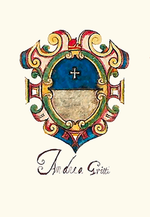Andrea Gritti

Andrea Gritti (born April 17, 1455 in Bardolino , † December 28, 1538 in Venice ) was the 77th Doge of the Republic of Venice between 1523 and 1538, after he had already had a successful diplomatic and military career.
Life
Gritti spent the first politically active years of his life mainly in Constantinople , where he represented Venice's interests. In 1499 he was arrested on charges of espionage, but escaped execution because of his friendship with the vizier . Years later he was rehabilitated.
1509, after the Venetian defeat in the battle of Agnadello against Louis XII. Gritti was appointed leader of the Venetian Army in Treviso by the Council of Ten to support rebellions against the invaders. He managed to bring Padua back to the Venetian side and to defend the Cadore against the troops of Emperor Maximilian . In the following year 1510 , after the death of the previous captain general Nicolo di Pitigliano, Gritti took command of the entire Venetian army, but had to retreat to Venice due to the French advance. Until the end of the League of Cambrai , he was able to hold the front lines and defend Venice's position despite the first defeat of the Holy League . In 1512 Gritti left the Holy League after negotiations with Francis I and concluded an alliance with France.
Andrea was the father of Lodovico Gritti , a temporary ruler of Hungary.
The Doge's Office
After being elected Doge in 1523, Gritti signed a contract with Charles V , which ended Venice's participation in the Italian wars . He tried the neutrality of the Republic, despite the continued fighting between Francis I and Charles V maintain. In doing so, he urged both of them to turn their attention to the advance of the Ottoman Empire into Hungary . But he could not prevent Suleyman I from attacking Corfu in 1537 and thus forcing another war on Venice.
Domestically, Andrea Gritti turned the less wealthy aristocracy against her, the existence of which depended heavily on the offices reserved for them. The activity as a judge was particularly important, an office to which only nobles could be elected. Gritti wanted to introduce Roman law , which would have required the training of these lay judges. This training, in Padua or Bologna, was not affordable for the poor nobles. They succeeded in ensuring that lay judges remained in Venice, with a correspondingly high degree of freedom of judgment, as well as the orientation towards precedents.
photos
- Vincenzo Catena , attributed to: Andrea Gritti, around 1530, The National Gallery of Art, London
- Paris Bordone : The fisherman from Poveglia presents the doge with the ring. Gallerie dell 'Accademia , Venice
- Tintoretto : The Doge Andrea Gritti in front of the Madonna with the Child and Saints Marina, Bernhard, Ludwig and Markus, 1581/84, votive picture, Sala del Collegio, Doge's Palace , Venice
- Titian and workshop: The Doge Andrea Gritti, Modello, Metropolitan Museum , New York
- Titian: The Doge Andrea Gritti, National Gallery of Art , Washington
- Palma Giovane : Votive image of Doge Andrea Gritti, Doge's Palace, Sala del Collegio, Venice
Tomb
Andrea Gritti was first buried in San Zanipolo . In 1580 his body was transferred to the church of San Francesco della Vigna designed by Jacopo Sansovino, and Gritti had commissioned the laying of the foundation stone in 1534. There a simple inscription plaque reminds of the doge.
literature
- Mattia Camuffo: Andrea Gritti: Il doge della rinascita veneziana , tesi di laurea, Università Ca 'Foscari, Venice 2016 ( online ).
- John Julius Norwich: A History of Venice . Vintage Books, New York 1989, ISBN 0-679-72197-5
- Andrea Da Mosto : I dogi di Venezia , Florence 1983
- Manfredo Tafuri (Ed.): Renovatio urbis. Venezia nell'età di Andrea Gritti (1523-1538). Rome 1984
Web links
Individual evidence
- ↑ Gaetano Cozzi: Considerazioni sull'amministrazione della giustizia nella Repubblica di Venezia (secc. XV-XVI) , in: Florence and Venice: comparisons and relations, Vol. II: Cinquecento, Florence 1980, pp. 101-133.
| predecessor | Office | successor |
|---|---|---|
| Antonio Grimani |
Doge of Venice 1523 - 1538 |
Pietro Lando |
| personal data | |
|---|---|
| SURNAME | Gritti, Andrea |
| BRIEF DESCRIPTION | Doge of Venice |
| DATE OF BIRTH | April 17, 1455 |
| PLACE OF BIRTH | Bardolino |
| DATE OF DEATH | December 28, 1538 |
| Place of death | Venice |

